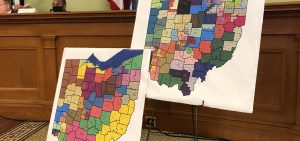News
The Supreme Court directs Ohio’s top court to take another look at a redistricting lawsuit
By: David A. Lieb | AP
Posted on:
WASHINGTON (AP) — The Ohio Supreme Court will take yet another look at the legality of the state’s congressional districts after the U.S. Supreme Court on Friday set aside a ruling striking down the districts and ordered further consideration of the case.

But the high court said state courts still must act within “ordinary bounds” when reviewing laws governing federal elections.
The Supreme Court’s brief order Friday was the fourth this month addressing redistricting conducted by states based on the 2020 census. Its other decisions dealt with Republican-drawn U.S. House districts in Alabama and Louisiana, which lower courts said likely violated the federal Voting Rights Act by diluting the voting strength of Black residents.
In both Ohio and North Carolina, Republican state lawmakers contended in appeals that their state’s highest court had gone too far when striking down U.S. House districts enacted by GOP state officials.
Unlike in North Carolina, Ohio’s constitution contains a specific anti-gerrymandering amendment, which was overwhelmingly approved by voters. That provision gives Ohio’s high court the authority to determine if a map “unduly favors or disfavors a political party” but not to draw a replacement.
The Ohio Supreme Court twice struck down congressional maps drawn by Republican officials after the 2020 census, although the second map nonetheless was used in the 2022 elections. That map resulted in 10 Republicans and five Democrats winning election.
In their appeal to the U.S. Supreme Court, Republican lawmakers in Ohio had claimed that state justices overstepped their authority by setting their own definitions for what fair maps should look like, including an acceptable partisan make up.
Like in North Carolina, Ohio’s Supreme Court underwent a realignment while an appeal was pending before the U.S. Supreme Court. Former state Chief Justice Maureen O’Connor, a Republican who cast key swing votes that tossed the congressional districts, retired in December due to age limits. She was succeeded by another Republican, former Hamilton County Prosecutor Joe Deters — a change that has raised the prospects of a different outcome when the court next considers redistricting.
North Carolina’s constitution contains no explicit prohibition on partisan gerrymandering. But judges there had cited constitutional sections guaranteeing “free” elections, “equal protection of the laws” and the right to free speech and assembly when ruling against overly partisan districts.
Last year, a Democratic majority of the North Carolina Supreme Court struck down congressional districts drawn by the Republican-led General Assembly and instead allowed a map drawn by judges to be used for the 2022 elections. That map resulted in Democrats and Republicans equally splitting the state’s 14 congressional districts.
Republican lawmakers had already planned to redraw those districts before the 2024 elections. Then, while the case was on appeal to the U.S. Supreme Court, voters elected a Republican majority to the state Supreme Court. Those judges in April overruled the previous decision and declared there was no constitutional prohibition on partisan gerrymandering.
___
Associated Press writer Julie Carr Smyth contributed to this report.

